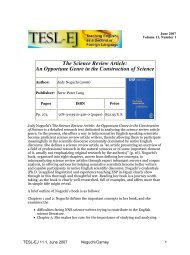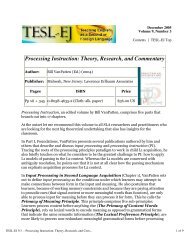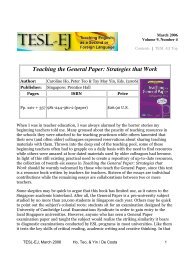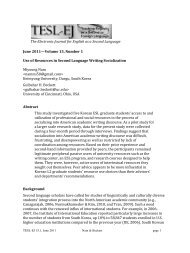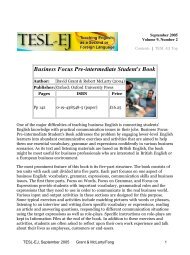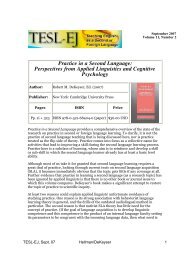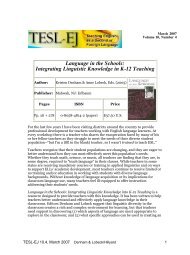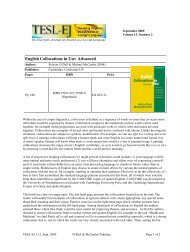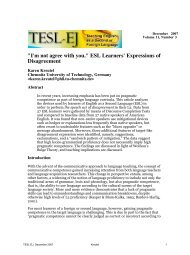TESL-EJ 11.3 -- Understanding Language Teaching: From Method ...
TESL-EJ 11.3 -- Understanding Language Teaching: From Method ...
TESL-EJ 11.3 -- Understanding Language Teaching: From Method ...
You also want an ePaper? Increase the reach of your titles
YUMPU automatically turns print PDFs into web optimized ePapers that Google loves.
December 2007<br />
Volume 11, Number 3<br />
Top<br />
<strong>Understanding</strong> <strong>Language</strong> <strong>Teaching</strong>: <strong>From</strong> <strong>Method</strong> to<br />
Postmethod<br />
Author: B. Kumaravadivelu (2006)<br />
Publisher:<br />
New York: Routledge<br />
Pages ISBN Price<br />
Pp. xvii + 258 978-0-8058-5676-7 (paper) $29.95 U.S.<br />
Kumaravadivelu's book on language teaching aims to illustrate "the pattern that<br />
connects the various elements of learning, teaching, and teacher education" in<br />
language teaching (p. xiii). As can be deduced from the title, the major theme of the<br />
book cites the emergence of a postmethod condition in the literature on teaching<br />
second/foreign languages. This emerging postmethod state has been commented on<br />
by other writers such as Brown (2002), Richards (2001) and Adamson (2004).<br />
However, Kumaravadivelu has what I perceive to be a very personalized vision of<br />
language teaching and the "postmethod" state of English language teaching. He<br />
illustrates this by first grounding the reader in the concepts of language, language<br />
acquisition, and language teaching, as well as a comprehensive discussion of<br />
methodology in language teaching.<br />
Kumaravadivelu draws upon the themes of earlier writings (for example his previous<br />
book "Beyond methods: macrostrategies for language teaching"). He discusses how<br />
methods evolved and what their originators were trying to achieve, and then critically<br />
evaluates those methods. A theme emerges that methods and predetermined<br />
materials and strategies lack the flexibility to be applied to the many varied contexts<br />
of English <strong>Language</strong> <strong>Teaching</strong>. This failing triggered the present postmethod state, in<br />
which postmethod pedagogies can be differentiated from methods by a broader<br />
focus, an emphasis on developing teachers' skills, and flexibility to meet students'<br />
needs. Kumaravadivelu tackles what he calls the "higher order tenets of language<br />
pedagogy" (p. xv). In drawing these themes together, Kumaravadivelu writes in a<br />
scholarly but accessible manner and is a wonderful communicator. His discussion<br />
and critique of methods is the most comprehensive and detailed I have read.<br />
<strong>TESL</strong>-<strong>EJ</strong>, December 2007 Kumaravadivelu/Skilton 1
As noted briefly above, the author's goal is "to explore the pattern which connects the<br />
higher order philosophical, pedagogical, and ideological tenets and norms of the<br />
language teaching enterprise"(p. 224). Each chapter, and indeed the book as a whole,<br />
features the preview-body-summary format, which reflects the author's intention to<br />
unearth the "pattern which connects" (p. xiii), in turn giving the book continuity.<br />
The book is divided into three major sections: <strong>Language</strong>, Learning and <strong>Teaching</strong>;<br />
<strong>Language</strong> <strong>Teaching</strong> <strong>Method</strong>s; and Postmethod Perspectives. The first section<br />
(Chapters 1-3) discusses language as system, discourse and ideology, and explores<br />
and synthesizes the contemporary literature on adult second language acquisition in<br />
formal contexts and its application to teaching. This section is informative and<br />
detailed; as such it is a valuable resource for anyone studying the nature of language<br />
and language teaching.<br />
The second section (Chapters 4-7) provides "a brief history, description, and<br />
assessment of language teaching methods" (p. xvi). These are correlated with the<br />
conceptual framework outlined in the earlier chapters. This is another strength of the<br />
book. The author categorizes methods as language-centered, learner-centered, and<br />
learning-centered, and provides extensive critiques. These critiques are well written,<br />
but also of great value are the connections he draws among the various methods.<br />
Kumaravadivelu states directly that he offers a methods analysis and not a teaching<br />
analysis. As the author explains, "a methods analysis can be done. ... by analyzing and<br />
interpreting what has been written about methods, but a teaching analysis can be<br />
done only by entering the classroom arena where a method or a combination of<br />
methods is used" (p. xvii). Kumaravadivelu revisits this explanation on pages 157 and<br />
166.<br />
Despite his acknowledgment, if this book has a weakness it is (1) that in section 2 a<br />
literature analysis is used to explain the emergence of a postmethod state, and (2)<br />
that this postmethod state exists only in the literature (amongst writers, academics,<br />
teacher trainers and so forth). Virtually nothing is known of how methods are or<br />
were enacted in the classroom, or if indeed they were at all, and the same can be said<br />
for the postmethod state. The author uses what little classroom research has been<br />
done to demonstrate that it would seem that teachers do not enact methods as they<br />
have been prescribed by the methods' orginators: "Teachers seem to be convinced<br />
that no single theory of learning and no single method of teaching will help them<br />
confront the challenges of everyday teaching . . . there is a significant variance<br />
between what the theorists advocate and what teachers do" (p. 166). I would argue<br />
that the practice of teaching has always been in somewhat of a postmethod state in<br />
that teachers have always modified methods, and incorporated them with other<br />
methods and pedagogies to suit the teaching context. I believe this gulf between<br />
theory and classroom practice illustrates a predicament of language-teaching theory,<br />
how far removed theory often is from classroom research and data. Therefore, the<br />
deconstruction of methods is mainly an academic exercise. It is not based on the<br />
reality of teaching or on the classroom. To me, these chapters are relevant for<br />
writers or theorists rather than for practicing teachers.<br />
The third section, Postmethod Perspectives, begins with a discussion of the<br />
parameters of postmethod pedagogy. Three frameworks for postmethod pedagogies<br />
are then offered: the author's own Macrostrategic Framework, the Three<br />
<strong>TESL</strong>-<strong>EJ</strong>, December 2007 Kumaravadivelu/Skilton 2
Dimensional Framework by Stern, and the Exploratory Practice Framework by<br />
Allwight. The final chapter discusses the challenges and barriers to postmethod<br />
pedagogies.<br />
I found this final section the most compelling reading. Here Kumaravadivelu outlines<br />
his vision, noting the positive research contributions over the decades yet<br />
acknowledging that contexts are very real determinants of pedagogy. The<br />
postmethod condition commends strategies to "advance a context-sensitive,<br />
location-specific pedagogy that is based on a true understanding of local linguistic,<br />
socio-cultural, and political particularities" (p. 224). An approach to language<br />
teaching that embraces such situational criteria is relevant to any teacher's,<br />
researcher's or attentive student's awareness of just what is being taught how. While<br />
it may go without saying that incorporating such postmethods into teacher training<br />
is thus desirable, the author reinforces this need by stressing the links, not always<br />
apparent, between pedagogies and ideologies.<br />
As a teacher, I found Kumaravadivelu's book insightful, unique, and at times<br />
inspiring. Nevertheless, since most of the book's pages theoretically analyze method<br />
and postmethod and are not concerned with how methods are enacted in classrooms,<br />
I believe that the book would be most useful for those studying or teaching on courses<br />
in TESOL or Applied Linguistics or researching and writing about teaching methods.<br />
That said, the book is written with such clarity and without avoiding complex and<br />
controversial ideas in the method-postmethod debate that it should have value as well<br />
for a much wider audience.<br />
References<br />
Adamson, B. (2004). Fashions in language teaching methodology. In A. Davies and C.<br />
Elder (Eds.), The handbook of applied linguistics (pp. 604-622). Oxford: Blackwell.<br />
Brown, H.D. (2002). English language teaching in the "post-method" era: Toward<br />
better diagnosis, treatment, and assessment. In J. C. Richards and W. A. Renandya<br />
(Eds.), <strong>Method</strong>ology in language teaching: An anthology of current practice (pp.<br />
9-18). Cambridge: Cambridge University Press.<br />
Kumaravadivelu, B. (1994). The postmethod condition: Emerging strategies for<br />
second/foreign language teaching. TESOL Quarterly, 29: 27-48.<br />
Kumaravadivelu, B. (2003). Beyond methods: macrostrategies for language<br />
teaching. New Haven: Yale University Press.<br />
Lindsay Skilton<br />
Queensland University of Technology, Brisbane<br />
<br />
© Copyright rests with authors. Please cite <strong>TESL</strong>-<strong>EJ</strong> appropriately.<br />
<strong>TESL</strong>-<strong>EJ</strong>, December 2007 Kumaravadivelu/Skilton 3



